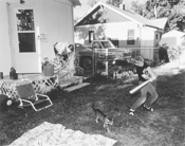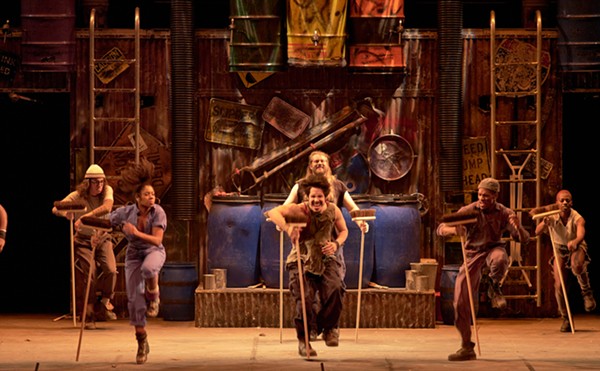Rupp has been photographing working-class families for more than 20 years now, but if this exhibit is any indication, she continues to find new and unsettling details where many photographers would not even bother to look. Now 57, Rupp is a Mansfield native who began her search for what she now calls "the human drama of the obvious" right here in Ohio. Her photographs can now be found in such collections as the Museum of Modern Art in New York and the Museum of Fine Art in Boston.
Rupp's background in sociology and psychology has undoubtedly been of help, and everywhere in this work one senses the observant eye of someone steeped in those disciplines. The psychologist seeks to understand human beings as individuals, while the sociologist aims at an understanding of people as participating members of a group and of a series of interlocking groups. Rupp combines both approaches in these photographs. The 22 shots, taken between 1996 and 1999, feature images of Beth (Rupp's niece) and her family. The work depicts the daily rituals that Beth and her family engage in -- bathing the kids, picnicking with friends at lake's edge, spending quiet time in the laundry-strewn living room. One learns much about Beth and something about each of the family members (including the household pets). But one also gets a larger picture of blue-collar life in America -- its strains, its stresses, and infrequently, its joys. Rupp balances the micro and the macro. She seems to be saying, "This is Beth's life, but don't forget there are many others like her. This is also their story."
What is that story? The life in these photos is one of paint-covered overalls, frayed living room sofas, and beer consumed out of the can. This is not exactly the stuff of high drama. One will not find any Willy Lomans here: These are not people who have deluded themselves about their station in life and who are now trying to convince everyone else that they are worldly successes. Instead, they seem to have accepted their lot in life, going about their daily affairs without concern for what others might think. Still, there is an undercurrent of dread that can't be denied. Raymond Carver frequently caught this dread in his short stories about working-class people who were unapologetically themselves, but who got no mileage from being so.
That mixture of independence and doom is on display in "Beth, Belt Creek, Montana," taken in 1999. This is the only shot in the show in which Rupp's niece is alone. Rupp usually shows her interacting with her children or her husband, so by its context, we can infer that this shot is somehow meant to modify or deepen the impression that we have formed of Beth from the rest of the show. She scowls at the camera, as though indicting it for its intrusiveness. One suspects that this might have something to do with the fact that she is wearing a bathing suit and that she is overweight. If elsewhere she has gone about her daily tasks without noticing the camera, now she might, with some irritation, be realizing that she has been the object of its steady gaze and that the truth is not all that flattering. Rupp, in this shot, does an interesting thing: She shows us that Beth is not a perpetually even-tempered child-care machine, but a human being capable of a range of emotions and attitudes, including anger, suspicion, and self-awareness.
Rupp seems to say throughout this exhibit that claustrophobia can be experienced even in the wide-open spaces of Montana. These adults go about their days as though their lives are one series of routines followed by another series of routines. When Beth and her husband share a quiet moment together on the couch, Rupp emphasizes the laundry all around them. It's a detail that gives the moment an acrid aftertaste. Too, the husband's clothes are streaked with paint, and he's holding a bottle of beer in one hand while he looks at his wife. One has the impression that 10 seconds from now, he'll return to his beer, his wife will fold the laundry, and the routines will resume their course. It's a moment of reprieve and thus a moment of joy, but Rupp is suggesting that moments like this occur infrequently.
These photos are full of well-observed details like the laundry that gets in the way of intimacy. Rupp knows that just the act of cataloguing the objects that people choose to place in their living rooms can tell us much about them. The diplomas that hang on the living room wall seem to be there as decoration, adjuncts to the graduation photos and the tapestries of horses striding through the woods. Rupp is not showing us these things to be cruel -- this, she is telling us, is a living room that contains clues about its owners. What do those clues disclose? Beth and her husband have created a child-centered universe, and they have decorated their interiors accordingly. The clincher is the Fisher-Price stuff that is scattered all over the place. The way Rupp photographs them, the brightly colored toys are precious objects. Remove one and the photo's carefully calibrated color harmonies will collapse.
Sometimes Rupp adds humor to her arsenal. There is something funny about these Sunday picnics at the creek, which seem to consist of Doritos and Pepperidge Farm Milano cookies. Maybe the family ate before leaving for the creek, and these empty packages are meant to give us a taste (no pun intended) of which junk foods are popular in Great Falls. There is also a light mood in a shot like "Nick With a Hit, Great Falls, Montana." This one captures a moment of activity in which no one seems to be doing anything particularly important. Amid an arrangement of parked cars, houses, and outdoor clutter (more Fisher-Price toys), a young boy swings at a baseball. Behind him, his mother leans over another child, and the family's gray cat makes a cameo appearance. Rupp balances the shot by matching the triangular shape of a nearby house with the triangular fragment of lawn towel in the foreground. Also, she matches the color of Nick's blue jeans with his sibling's towel and a blue lawn chair. These compositional choices lend order and shape to a moment that seems structureless. This shot thus summarizes what Rupp does elsewhere in the show: She starts out with mundane tasks and activities, but by finding the thread that connects them, she discovers meaning in moments that many people would find just drab.
The occasional flashes of humor in shots like "Nick With a Hit" are short- lived. Overall, Rupp stresses the faintly ominous in her work. Glimpses of creeks and trees, for instance, cannot mitigate Beth's grim facial expression in her portrait; neither can the diplomas on the wall, which seem merely decorative. The photos are in full color, but Rupp seems to be lamenting the monochromatic existence that these people have been fated to lead.












